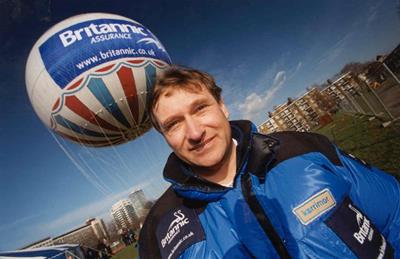The Last Great Aeronautical Adventure in The World
Radio Communication Company, Icom (UK) Ltd has come to the rescue of a prestigious attempt by British adventurer David Hempleman-Adams to cross the Arctic Circle in an open basket balloon. At short notice the company is supplying a wide range of specialist radio communication equipment that will act as a vital communication link between the balloon and its base of communications in Birmingham. The Britannic Challenge which will leave any time between now and the end of May hopes to create several world firsts – the crossing itself, reaching the Pole, landing a balloon on an arctic ice pack and surviving alone in a wicker basket for up to seven days in temperatures of – 60C!
The equipment that David Hempleman Adams will primarily be using is the IC-M710 GMDSS HF SSB marine transceiver. This is one of Icom's most successful products and is used as a vital communication tool for yachts and motor boats throughout the world. The IC-M710GMDSS meets GMDSS requirements for maritime safety and will be primarily used as the main operating transceiver between the balloon and its base in Birmingham. Icom (UK) Ltd have also supplied the expedition with its popular IC-A3E & IC-A22E airband handheld radio transceivers. These will be used as important backup for communications during the flight.
The IC-M710GMDSS transceiver uses HF radio technology to give worldwide communication coverage. HF radio communication was needed as a result of the demise of Iridium, the recently bankrupt satellite Communications Company. As a result, 66 of its satellites are going to be allowed to burn up in orbit therefore making more than 50,000 users with mobile phones inoperative - including all the projects communication equipment. Icom HF equipment was also a logical choice for the team as it had been used several times in Richard Branson's attempts to fly around the world in his Challenger balloons and in his transatlantic marine challenges.
David Hempleman Adams is trying to recapture the spirit of courage and adventure of French balloonist, Andrée, whose 1897 attempt to reach the North Pole ended in tragedy when a sudden change in wind directions forced him to crash-land on the Polar ice cap and he and his team subsequently died. No one has succeeded in making the Polar crossing since. The Challenge will use a traditional Roziere balloon, a wicker basket and take-off from the same point - Spitsbergen in Norway. The Roziere balloon is similar to the Breitling Orbiter that went round the world in 1999, but a tenth of the size at 90,000 cubic feet and with an open basket.
David has assembled a world class team to ensure success for the Britannic Challenge. Around the World pilot Brian Jones will run the control centre from Britannic's Birmingham Headquarters and Luc Trullemans, weatherman for the last three Around the World attempts, will be responsible for the all important weather predictions, on which Hempleman-Adams will depend entirely throughout the flight.
The initiative is considered to be more difficult than recent attempts to fly around the world. The combination of ballooning and cold climate skills required, the extreme weather patterns and cruel skies of the Arctic have succeeded in keeping man away.
David Hempleman-Adams said, "This will be the greatest and most dangerous challenge I have ever faced in over 25 years of risk- taking. If we succeed, it will be the pinnacle of the adventurer's progress and prove yet again what we can achieve with the right team and motivation. And if we fail, we will still learn new lessons in endurance and survival that will help us, or our successors, to fulfil their potential."
Ian Lockyer, Marketing Executive at Icom UK Ltd said, "Icom have been making quality equipment for the last 40 years and it is only right that it should make its debut in the arctic. I want to wish David the best of luck with his adventure and hope that he comes back safe and sound with a new set of records for Great Britain."
And as for the ill-fated Iridium satellites, which have a lifespan of about five years and have special motors used to make adjustments in their orbit. To de-orbit the satellites, those motors will make the low point of the orbit lower into the atmosphere. Eventually, the satellites will burn up and the debris will hopefully land in the ocean, according to George Levin, who sits on the National Research Council's aeronautics and space engineering board.
Icom UK Marketing -
marketing@icomuk.co.uk
18/08/2000

